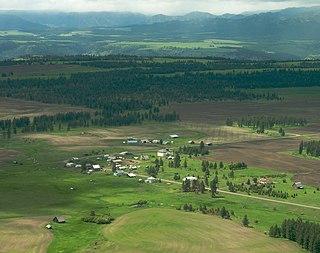The History of Ecuador extends over an 8,000-year period. During this time a variety of cultures and territories influenced what has become the Republic of Ecuador. The history can be divided into six eras: Pre-Columbian, the Conquest, the Colonial Period, the War of Independence, Gran Colombia, and Simón Bolívar the final separation of his vision into what is known today as the Republic of Ecuador.

The Viceroyalty of New Spain was an integral territorial entity of the Spanish Empire, established by Habsburg Spain during the Spanish colonization of the Americas. It covered a huge area that included territories in North America, South America, Asia and Oceania. It originated in 1521 after the fall of Mexico-Tenochtitlan, the main event of the Spanish conquest, which did not properly end until much later, as its territory continued to grow to the north. It was officially created on 8 March 1535 as a viceroyalty, the first of four viceroyalties Spain created in the Americas. Its first viceroy was Antonio de Mendoza y Pacheco, and the capital of the viceroyalty was Mexico City, established on the ancient Mexico-Tenochtitlan.

The Viceroyalty of Peru was a Spanish imperial provincial administrative district, created in 1542, that originally contained modern-day Peru and most of Spanish-ruled South America, governed from the capital of Lima. The Viceroyalty of Peru was one of the two Spanish Viceroyalties in the Americas from the sixteenth to the eighteenth centuries.

Nicoya, a city on the Nicoya Peninsula of the Guanacaste province, Costa Rica, is one of the country's most important tourist zones; it serves as a transport hub to Guanacaste's beaches and national parks. According to the 2000 census, the city's population was 13,334; second in the province only to Liberia. The city is the district seat of a cantón of the same name, which in 2013 had 24,946 residents.
The Real Audiencia, or simply Audiencia, was an appellate court in Spain and its empire. The name of the institution literally translates as Royal Audience. The additional designation chancillería was applied to the appellate courts in early modern Spain. Each audiencia had oidores.
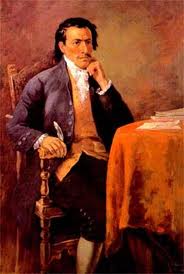
Francisco Javier Eugenio de Santa Cruz y Espejo was a medical pioneer, writer and lawyer of mestizo origin in colonial Ecuador. Although he was a notable scientist and writer, he stands out as a polemicist who inspired the separatist movement in Quito. He is regarded as one of the most important figures in colonial Ecuador. He was Quito's first journalist and hygienist.

A décima is a ten-line stanza of poetry, and the song form generally consists of forty-four lines. It is also called "espinela" after its founder, Vicente Espinel (1550–1624), a Spanish writer and musician of the Siglo de Oro.

The Ecuadorian War of Independence was fought from 1820 to 1822 between several South American armies and Spain over control of the lands of the Royal Audience of Quito, a Spanish colonial administrative jurisdiction from which would eventually emerge the modern Republic of Ecuador. The war ended with the defeat of the Spanish forces at the Battle of Pichincha on May 24, 1822, which brought about the independence of the entire Presidencia de Quito. The Ecuadorian War of Independence is part of the Spanish American wars of independence fought during the first two decades of the 19th century.

Lands administrative divisions of Australia are the cadastral divisions of Australia for the purposes of identification of land to ensure security of land ownership. Most states term these divisions as counties, parishes, hundreds, and other terms. The eastern states of Queensland, New South Wales, Victoria and Tasmania were divided into counties and parishes in the 19th century, although the Tasmanian counties were renamed land districts in the 20th century. Parts of South Australia (south-east) and Western Australia (south-west) were similarly divided into counties, and there were also five counties in a small part of the Northern Territory. However South Australia has subdivisions of hundreds instead of parishes, along with the Northern Territory, which was part of South Australia when the hundreds were proclaimed. There were also formerly hundreds in Tasmania. There have been at least 600 counties, 544 hundreds and at least 15,692 parishes in Australia, but there are none of these units for most of the sparsely inhabited central and western parts of the country.
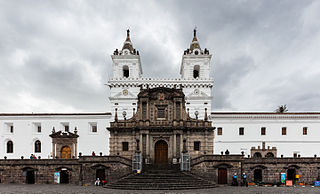
The Church and Monastery of St. Francis, commonly known as el San Francisco, is a 16th-century Roman Catholic complex in Quito, Ecuador. It fronts onto its namesake Plaza de San Francisco. The imposing structure has the distinction of being the largest architectural ensemble among the historical structures of colonial Latin America and for this reason is sometimes known as "El Escorial of the New World". The style evolved over almost 150 years of construction (1534-1680) through earthquakes and changes in artistic fashion. The Church houses the city's beloved Virgin of Quito (1734).
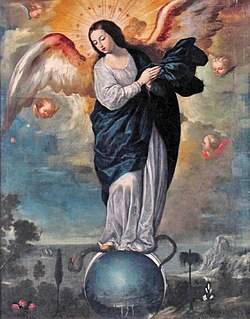
The Quito School is a Latin American artistic tradition that constitutes essentially the whole of the professional artistic output developed in the territory of the Royal Audience of Quito — from Pasto and Popayán in the north to Piura and Cajamarca in the south — during the Spanish colonial period (1542-1824). It is especially associated with the 17th and 18th centuries and was almost exclusively focused on the religious art of the Catholic Church in the country. Characterized by a mastery of the realistic and by the degree to which indigenous beliefs and artistic traditions are evident, these productions were among of the most important activities in the economy of the Royal Audience of Quito. Such was the prestige of the movement even in Europe that it was said that King Carlos III of Spain (1716–1788), referring to one of its sculptors in particular, opined: "I am not concerned that Italy has Michelangelo; in my colonies of America I have the master Caspicara".
Eduardo Estrella Aguirre was an Ecuadorian doctor and researcher who published Flora Huayaquilensis: The Botanical Expedition of Juan Tafalla 1799-1808.
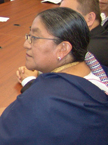
Nina Pacari, born as María Estela Vega Conejo is a Kichwa politician, lawyer and indigenous leader from Ecuador.
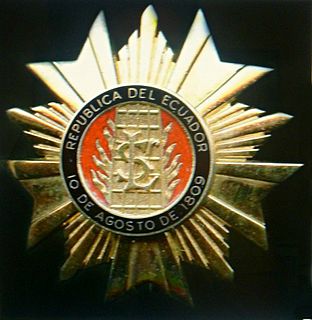
The National Order of San Lorenzo was established as a military order medal by the President of the First Revolutionary Government of Quito, Juan Pío Montúfar, II Marquis de Selva Alegre, by a decree issued on August 17, 1809, in the Capitulate Hall of the Convent of San Agustín. All the members of the revolutionary Council were decorated with it. Once the Council disappeared and the power returned to Spanish hands, the Order also ceased for more than a century.

Pomasqui Valley is a valley on the northern outskirts of Quito, Ecuador. It is located on the equator, the so-called "Mitad del Mundo", at an altitude of around 2,600 metres (8,500 ft) above sea level. Hot and semi-arid, it is formed by a river tributary. The valley contains the Cerro de Catequilla, which contains the pre-Columbian astronomical observatory, Catequilla. The village of Pomasqui itself lies roughly 6 kilometres (3.7 mi) from the equator. The Monjas River flows nearby and the valley is an important centre for viniculture in Ecuador, with vineyards. The economy features vegetable and fruit production. To the northwest is the Pululahua Geobotanical Reserve.

The Acala Chʼol were a former Chʼol-speaking Maya people who occupied a territory to the west of the Manche Chʼol and east of the Chixoy River in what is now the Alta Verapaz Department of Guatemala. The Acala should not be confused with the people of the former Maya territory of Acalan, near the Laguna de Terminos in Mexico.
The following is a timeline of the history of the city of Quito, Ecuador.
Quilago (1485–1515) was a chieftainess or queen regnant of the Cochasquí in Ecuador, famed for her defense of the Cochasquí against the expansion of the Inca Empire.

Indochristian art, or arte indocristiano, is a type of Latin American art that combines European colonial influences with Indigenous artistic styles and traditions.
María Luisa Gómez de la Torre Páez was an Ecuadorian feminist, educator, and activist. She was a pioneer in the struggle for the rights of the indigenous peoples and peasants in Ecuador. She was the first woman to serve as a teacher for boys in Quito.


